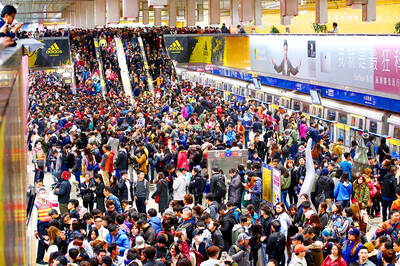Chinese Nationalist Party (KMT) Taipei city councilors yesterday said they would try to cut Taipei Mayor Ko Wen-je’s (柯文哲) second reserve fund from NT$1.25 billion to NT$800 million (US$38.8 million to US$24.8 million), citing Ko’s poor use of the fund last year.
Ko has again proposed a NT$1.25 billion budget for this year’s second reserve fund, which is unreasonable, given that the mayor only used 29.8 percent of the fund last year, KMT Taipei City Councilor Wang Hsin-yi (王欣儀) told a news conference in Taipei.
Ko’s administration last year earmarked NT$717 million of the fund, but only used NT$361 million, of which NT$160 million was used to cover an increase in pensions the municipal government was required to allocate following an amendment to Article 56 of the Labor Standards Act (勞動基準法), she said.
Ko is requesting a budget for the fund larger than those requested by any of his predecessors, which is superfluous and at odds with the spirit of the Budget Act (預算法), Wang said, adding that Ko approved NT$230 million from the fund for construction work, of which NT$160 million has remained unused.
She also criticized Ko’s use of the fund, citing as examples a traffic improvement plan on Zhongxiao W Road and road leveling plans around venues to be used for this year’s Universiade, which were carried out using the fund to “cover unexpected needs related to the implementation of city policies,” which she said reflected Ko’s foresight in policy implementation.
Quoting Ko, who said the fund remained mostly untapped because fewer typhoons hit Taipei last year, which reduced rescue and cleanup expenses, Wang urged Ko to refrain from such false rhetoric, as the city government was last year granted NT$700 million for a disaster reserve fund.
Ko has requested the same amount for the reserve fund as last year to save face, in an effort to hide his inability to effectively use the money, KMT Taipei City Councilor Chin Huei-chu (秦慧珠) said.
The second reserve fund should only be used for pressing matters, but Ko has used it to renovate sinks at Taipei City Hall and move flower stands at the Wanhua District Office, KMT Taipei City Councilor Li Keng Kuei-fang (厲耿桂芳) said.
Meanwhile, a project related to air conditioning at the Taipei Fine Arts Museum and procurements for the establishment of an online payment platform have remained in limbo since January last year, when Ko approved NT$7.67 million and NT$6.93 million respectively from the reserve fund for the projects, KMT Taipei City Councilor Wang Hung-wei (王鴻薇) said.
In response to reporters’ requests for comment, Ko said that expending the fund is not the point, as it should only be used when necessary.
“Previous mayors used the second reserve fund however they liked, but I have a standard operating procedure for its use,” Ko said. “That I was given a larger fund does not mean I misused it. I spent less money by being prudent.”

People can take the Taipei MRT free of charge if they access it at Nanjing Sanmin Station or Taipei Arena Station on the Green Line between 12am and 6am on Jan. 1, the Taipei Department of Transportation said on Friday, outlining its plans to ease crowding during New Year’s events in the capital. More than 200,000 people are expected to attend New Year’s Eve events in Taipei, with singer A-mei (張惠妹) performing at the Taipei Dome and the city government’s New Year’s Eve party at Taipei City Hall Plaza, the department said. As people have tended to use the MRT’s Blue or

Civil society groups yesterday protested outside the Legislative Yuan, decrying Chinese Nationalist Party (KMT) efforts to pass three major bills that they said would seriously harm Taiwan’s democracy, and called to oust KMT caucus whip Fu Kun-chi (傅?萁). It was the second night of the three-day “Bluebird wintertime action” protests in Taipei, with organizers announcing that 8,000 people attended. Organized by Taiwan Citizen Front, the Economic Democracy Union (EDU) and a coalition of civil groups, about 6,000 people began a demonstration in front of KMT party headquarters in Taipei on Wednesday, organizers said. For the third day, the organizers asked people to assemble

Taipei is participating in Osaka’s Festival of Lights this year, with a 3m-tall bubble tea light installation symbolizing Taiwan’s bubble tea culture. The installation is designed as a bubble tea cup and features illustrations of Taipei’s iconic landmarks, such as Taipei 101, the Red House and North Gate, as well as soup dumplings and the matchmaking deity the Old Man Under the Moon (月下老人), affectionately known as Yue Lao (月老). Taipei and Osaka have collaborated closely on tourism and culture since Taipei first participated in the festival in 2018, the Taipei City Department of Information and Tourism said. In February, Osaka represented

Taiwanese professional baseball should update sports stadiums and boost engagement to enhance fans’ experience, Chinese Professional Baseball League (CPBL) commissioner Tsai Chi-chang (蔡其昌) told the Liberty Times (sister paper of the Taipei Times) in an interview on Friday. The league has urged Farglory Group and the Taipei City Government to improve the Taipei Dome’s outdated equipment, including relatively rudimentary television and sound systems, and poor technology, he said. The Tokyo Dome has markedly better television and sound systems, despite being 30 years old, because its managers continually upgraded its equipment, Tsai said. In contrast, the Taipei Dome lacked even a room for referees